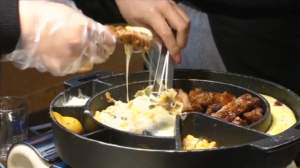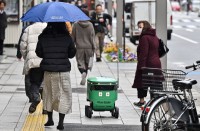 South Koreans, who traditionally eat most meals with a generous dollop of the fiery local side dish kimchi, are gaining a growing taste for another imported fermented food: cheese.
South Koreans, who traditionally eat most meals with a generous dollop of the fiery local side dish kimchi, are gaining a growing taste for another imported fermented food: cheese.
While Japan is by far the biggest consumer of cheese in Asia, neighbouring South Korea is one of the fastest-growing markets. The United States supplied 53 percent of South Korea’s cheese imports in the first nine months of this year, New Zealand with 13 percent, and the rest came from Germany, France and others, according to customs data.
Cheese demand has been helped by increased exposure to Western dishes such as pizza, but South Koreans also often incorporate cheese into local dishes like noodle soup and kimchi stir-fried rice.
Some diners at a restaurant said cheese helps to take away the heat from spicy dishes.
“My husband does not like spicy food, but he likes cheese so much. So, I think he can eat spicy foods easily by dipping it in cheese. Cheese added to food actually reduces the spicy taste,” said 29-year-old Kim Soo-min while eating spicy barbecue pork ribs with cheese.
South Koreans are now consuming 2.4 kg per person, according to industry data, but that is only about a tenth of the cheese consumed in France.
One South Korean mother of two children, Park Hyeon-young, said she preferred cheese as a snack for her children.
“I often give cheese to my kids as snacks. Cheese has various nutrients including calcium and protein, and I prefer it to other snacks. I think it also helps children, who need lots of energy and calories, to supplement their calorie intake,” Park said.
Hwang Keum-taek, a food and nutrition professor at Seoul National University, said South Koreans are used to fermented food, and therefore eating cheese was not a huge stretch for their palates.
“I think the main reason (of the increase in cheese consumption) is that people are frequently exposed to Western cultures, and another reason is that people eat a lot of fermented food in our country. So, they are less offended and repulsed by fermented food in this perspective,” he said.
South Korean cheese imports jumped 60 percent last year from 2010 to more than 97,200 tonnes, according to U.S. Department of Agriculture (USDA) data. Annual imports are now worth nearly $500 million.
One of South Korea’s largest hypermarket operators E-mart Traders said they are importing more cheese to meet the demand.
“E-Mart Traders sell 48 different kinds of imported cheese now, most of them are young people who look for and purchase cheese a lot. Therefore, the sales of imported cheese have been steadily increasing and we expect to see our sales continue to grow if we provide a wider selection of cheese for our customers,” said a manager of E-Mart Traders, Kim Jin-hyun.
South Korea is now the world’s fifth-biggest importer. The country’s combined cheese and curd imports have averaged 9,250 tonnes a month so far this year, 10 times more than 20 years ago and outstripping last year’s record 8,100 tonnes a month, customs data showed.
Top suppliers such as the United States and New Zealand hope to sell even more as free trade deals cut tariffs. (Reuters)







